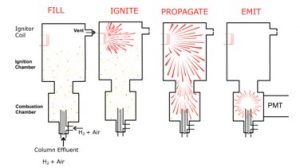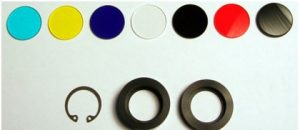PFPD guide
| Pulsed Flame Photometric Detector (PFPD), has a photomultiplier which looks at a flame within the detector. The signal is acquired from changes in colour of the flame. Each element has its own emission wavelength or colour (fluorescence). Band Pass Optical Filters are used to control which element is measured by filtering out light from other sources. The light from elemental emission is detected. |
How does the detector work ?
| A pulsed flame allows to selective amplification of element-specific emissions whilst minimising background noise which is impossible with a constant flame because all emissions are continuous. This means it is not possible to detect each emission individually. With the pulsed flame, the combustion of the elemental species lasts a lot longer than that of hydrocarbons and interferences. Once elemental combustion is complete, the flame will be extinguished then another flame is established to measure the next data point. The ON and OFF is called ‘pulsing’. The operation of a pulsed flame is detailed below and can be seen in Figure 1.
1. Fill: Combustible gas mixture fills the detector. The flame is OFF but the photomultiplier is ON and collecting, waiting for enough fuel for ignition to start. 2. Ignite: there is enough hydrogen and air in the ignition chamber to start a flame. Detection of ignition will start a gate delay timer. 3. Propagate: the flame moves to all the chambers which will combust the hydrocarbons and hydrogen. During this time the gate delay is active and the photomultiplier is not collecting data. 4. Emit: As compounds elute they undergo combustion where excited species will fluoresce. The gate width is active and the photomultiplier is collecting the selected emission data. This complete cycle takes around 300 milliseconds, and will repeat. You will hear a Tick-Tock sound every time this happens. Figure 1 Stages of pulsed flame operationPFPD modes
|
| The standard operating temperature for the PFPD detector whilst measuring is 200°C. Depending on your sample, you may require a higher detector temperature to adequately separate and detect higher boiling samples. The temperature can be set up to 300°C. |



